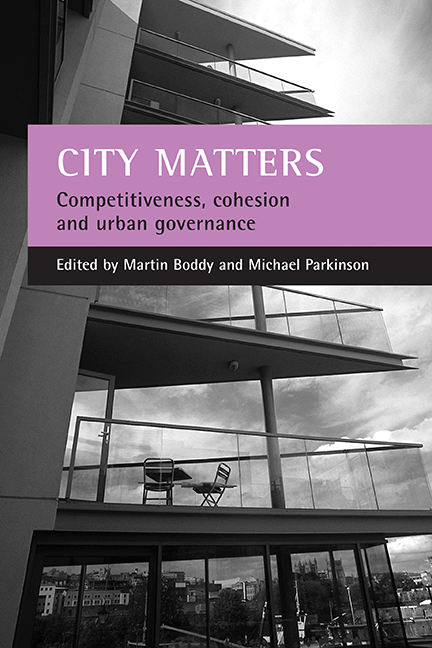Book contents
- Frontmatter
- Contents
- List of tables and figures
- Foreword
- Acknowledgements
- Notes on contributors
- one Introduction
- Part One Competitiveness, cohesion and urban governance
- Part Two Competitiveness and urban change
- Part Three Competitiveness, innovation and the knowledge economy
- Part Four Housing, property and economic performance
- Part Five Space, place and social cohesion
- Part Six Ethnicity, enterprise and social cohesion
- Part Seven Leadership, governance and social capital
- Conclusions
- Index
two - Sources of city prosperity and cohesion: the case of Glasgow and Edinburgh
Published online by Cambridge University Press: 20 January 2022
- Frontmatter
- Contents
- List of tables and figures
- Foreword
- Acknowledgements
- Notes on contributors
- one Introduction
- Part One Competitiveness, cohesion and urban governance
- Part Two Competitiveness and urban change
- Part Three Competitiveness, innovation and the knowledge economy
- Part Four Housing, property and economic performance
- Part Five Space, place and social cohesion
- Part Six Ethnicity, enterprise and social cohesion
- Part Seven Leadership, governance and social capital
- Conclusions
- Index
Summary
Although only 45 miles separate Edinburgh and Glasgow, the two largest cities in Scotland, they exhibit striking contrasts in their historic performance and social conditions. Severe deindustrialisation and decentralisation have left Glasgow with some of the most serious social and environmental problems in Britain. In recent years, however, there has been an economic turnaround, the extent and consequences of which have not been analysed in detail before. Edinburgh, on the other hand, has experienced accelerated growth over the last decade, causing tighter labour and property markets and displacement of population and jobs towards the urban edge and beyond. Congestion, high house prices and labour shortages arouse concern within the business and residential communities.
Integrative case studies of Glasgow and Edinburgh sought to explore issues of competitiveness and cohesion and to question the validity and underlying assumptions of these multifaceted concepts. Key questions that were addressed included, how important are local sources of competitiveness and cohesion in an increasingly open economy? Do social justice and economic success really go hand-in-hand in a modern economy? Is cohesion a significant source of economic prosperity, or exclusion a drag on long-term development prospects? The study involved unpacking the apparently simple concepts of competitiveness and cohesion and exploring their determinants and interrelationships through research on a variety of substantive issues. One strand of work, for example, involved identifying the main urban assets that facilitate or frustrate economic performance, including physical infrastructure, housing and social institutions. Another analysed the influence of deprived neighbourhoods, citizen participation and the labour market on social cohesion and prosperity. The study also sought to assess the strategic capacity of urban governance; that is, its ability to mobilise resources and negotiate a coherent vision for the city in the context of institutional fragmentation, micromanagement tendencies and intensified competition.
The Scottish study used a range of methods and data sources according to the questions addressed. Considerable effort went into assembling and manipulating existing public statistics to provide consistent data for comparable areas. An interim report analysed the changing economic, social and institutional structure of Central Scotland over the last two decades (Bailey et al, 1999).
- Type
- Chapter
- Information
- City MattersCompetitiveness, Cohesion and Urban Governance, pp. 13 - 32Publisher: Bristol University PressPrint publication year: 2004

